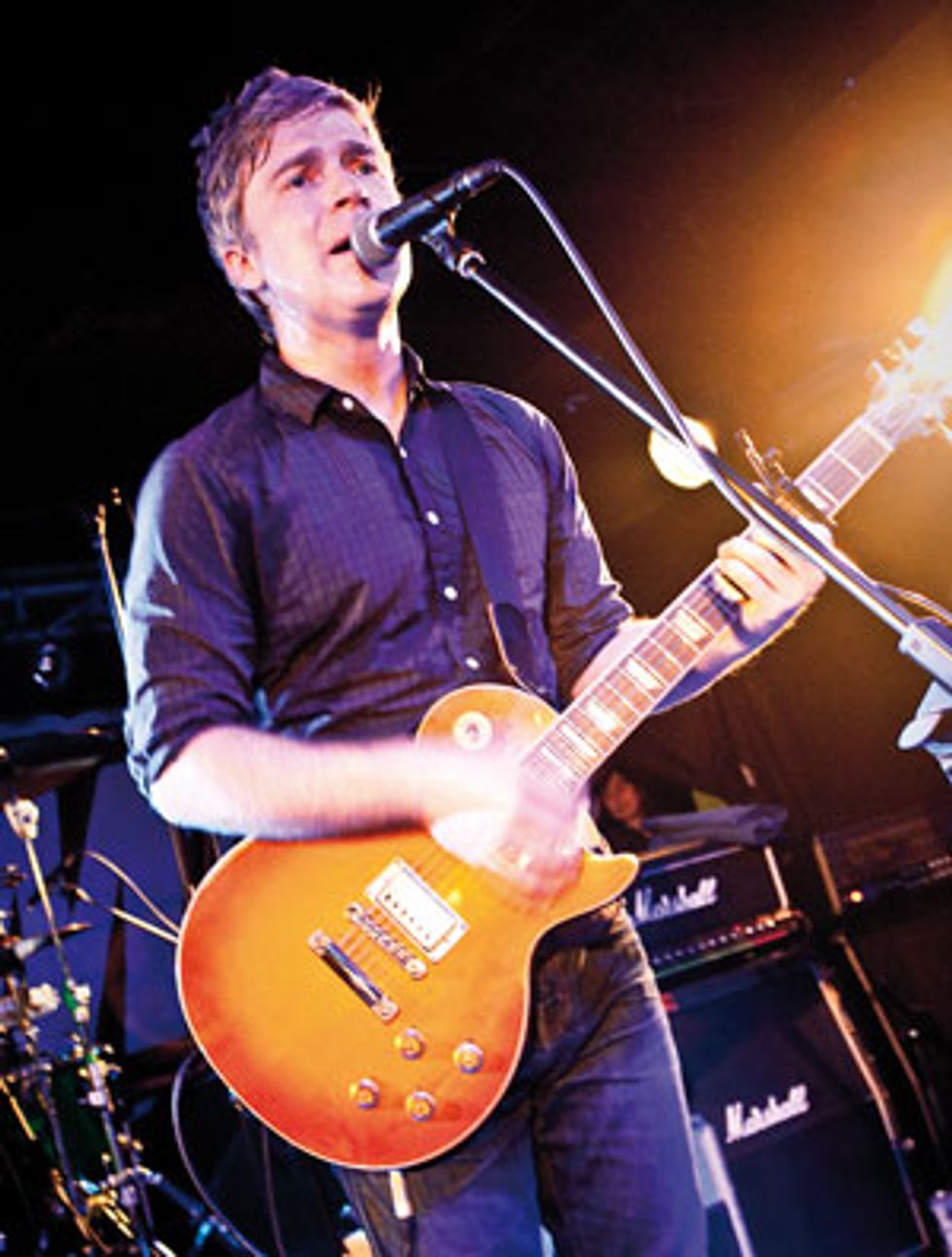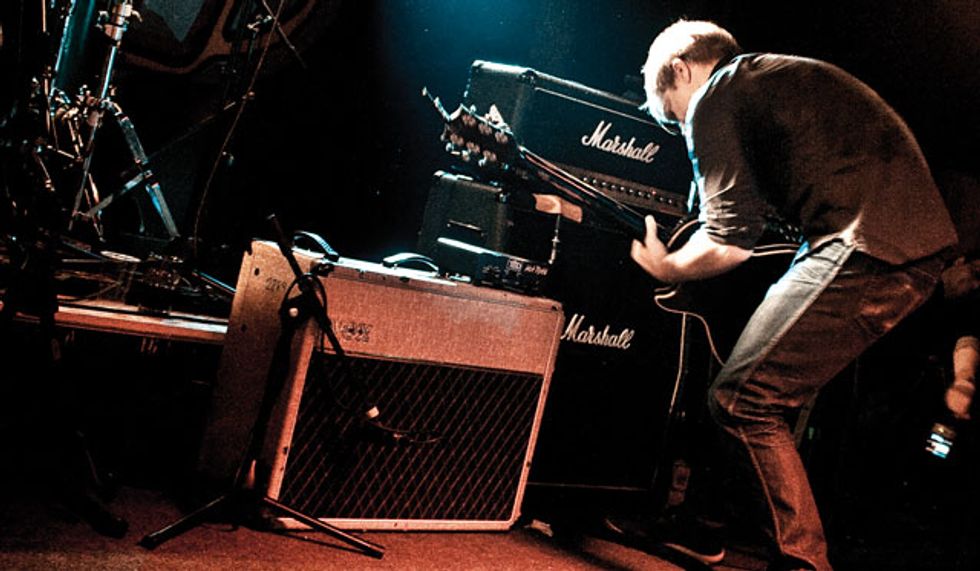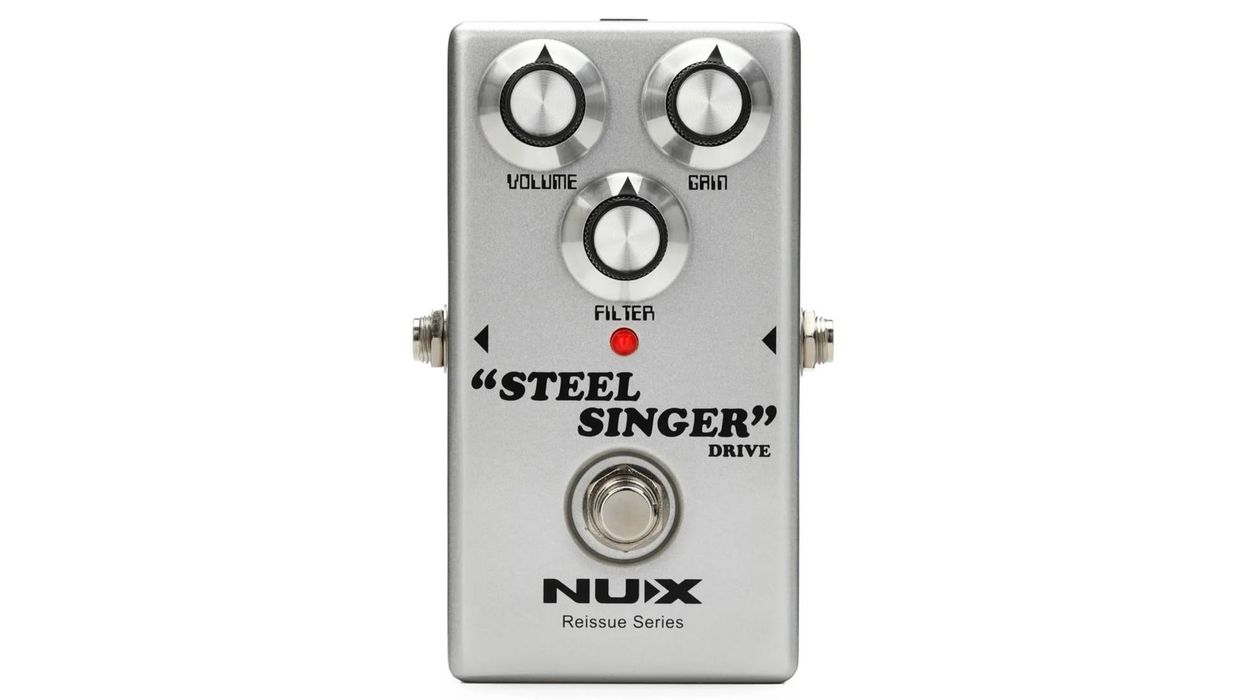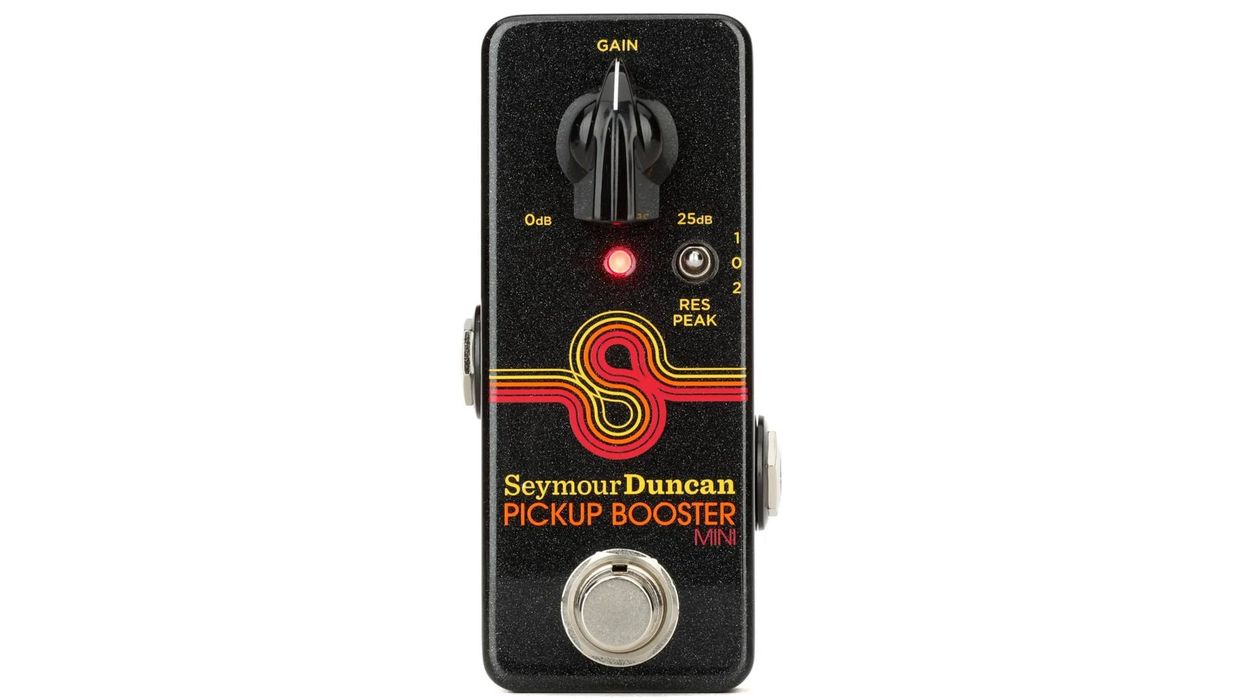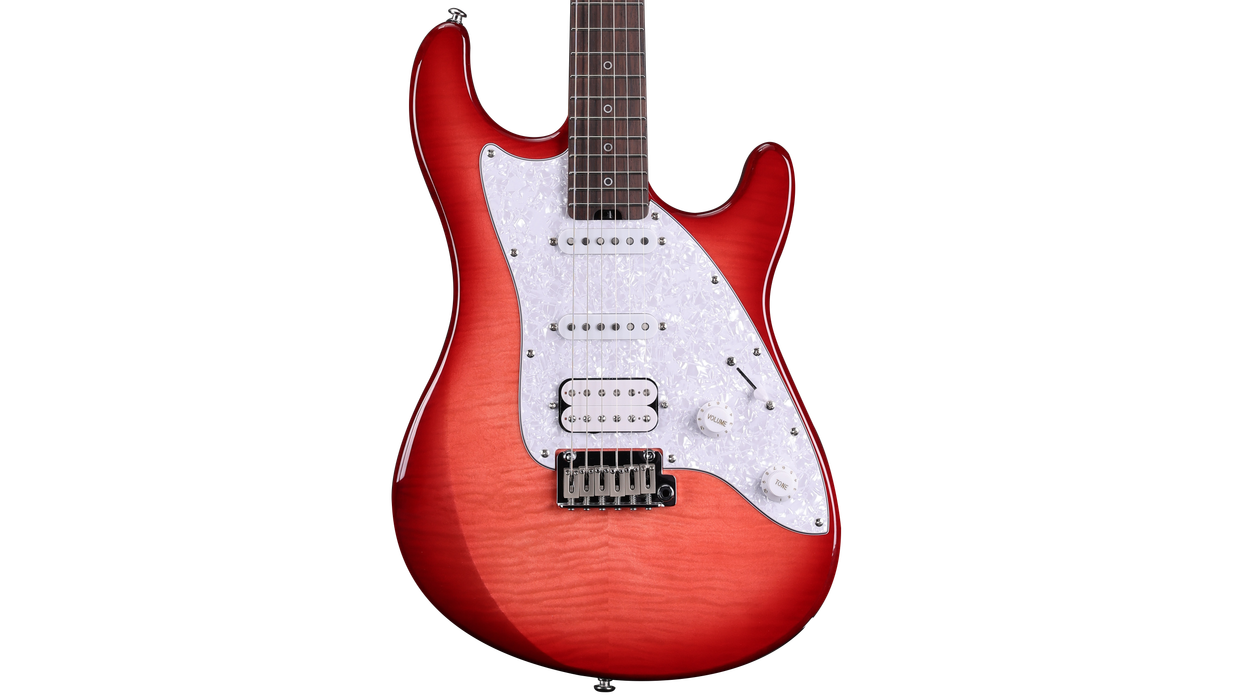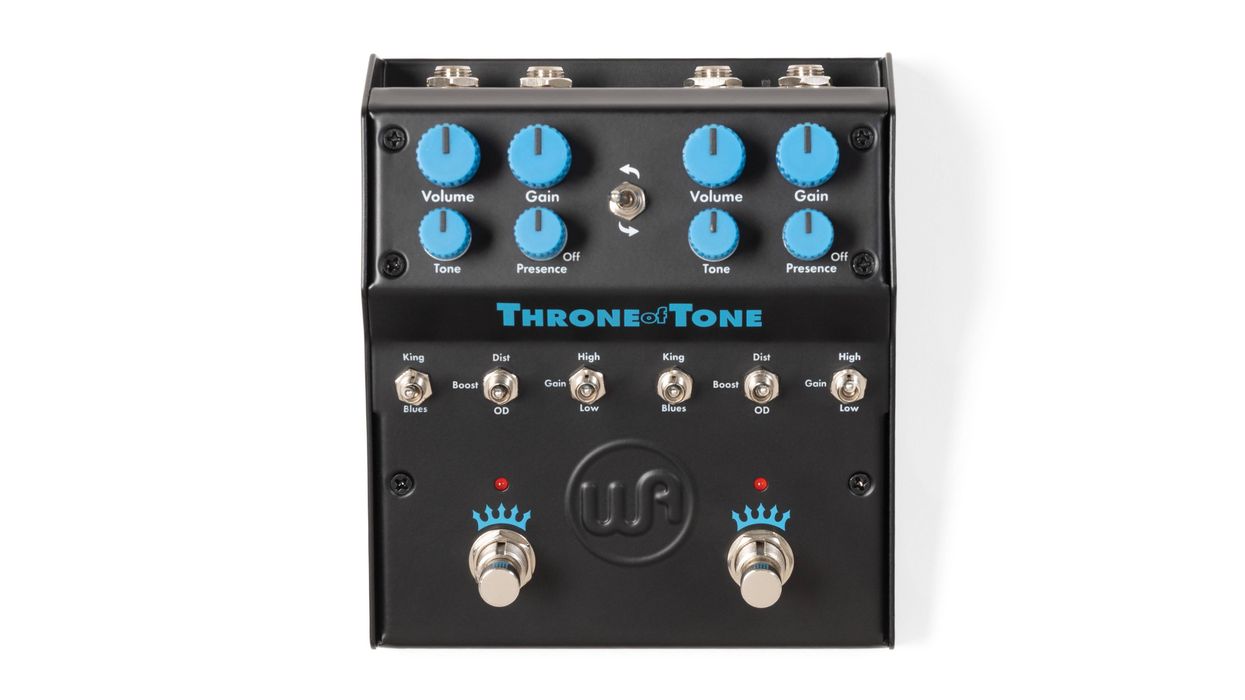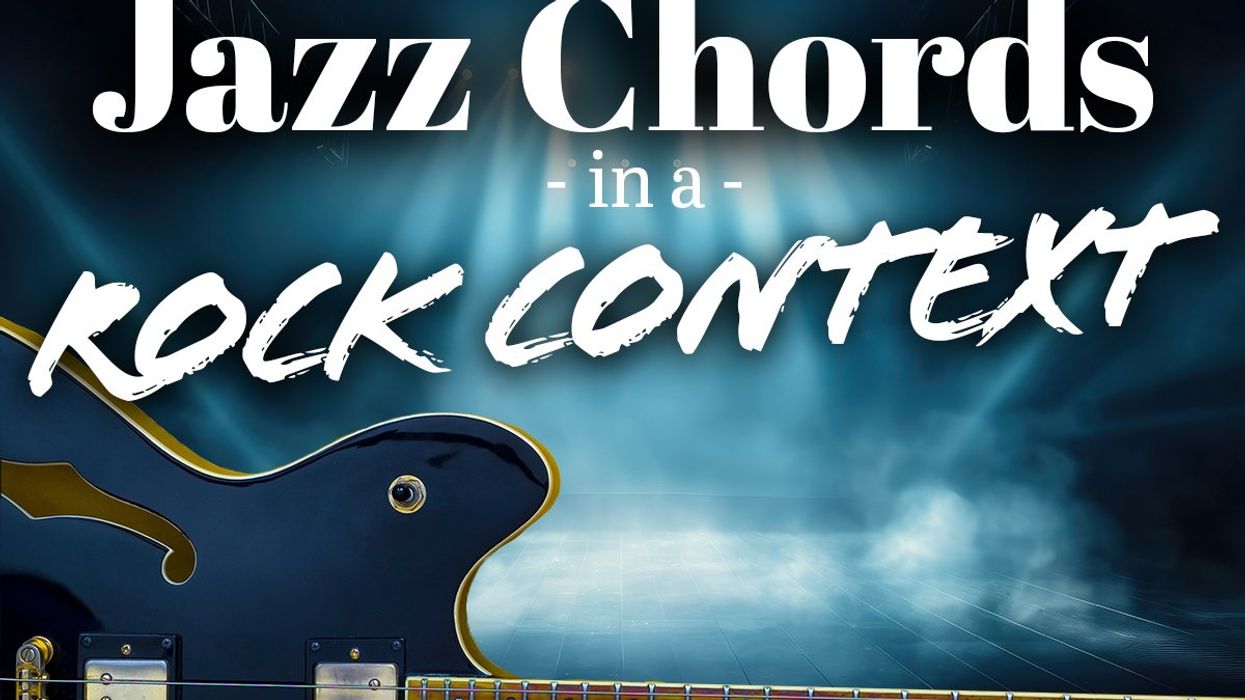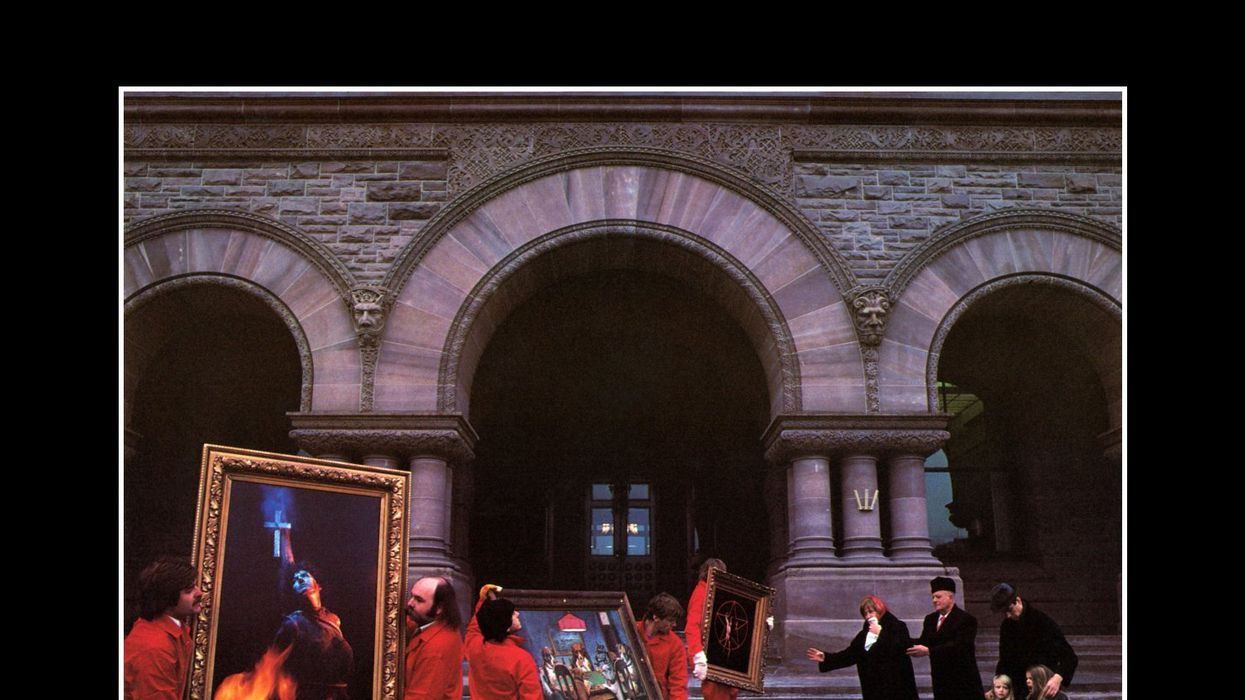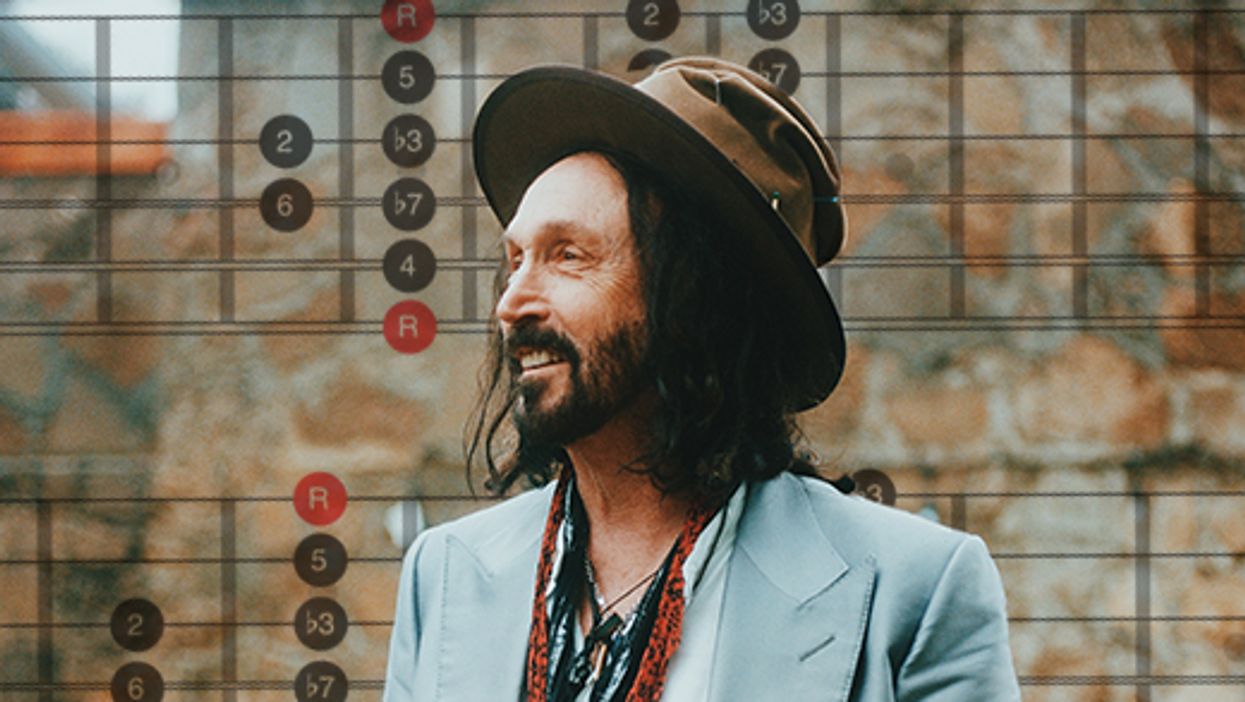Matthew Caws plays his trademark Les Paul at a concert in Italy on February
23, 2012. Photo by Marina Ravizza
Though Nada Surf’s first hit was the Weezer-esque “Popular” (from their 1996 debut album, High/Low, which was produced by the Cars’ Ric Ocasek), the irony for New York-based trio of Matthew Caws (vocals and guitars), Daniel Lorca (bass/vocals), and Ira Elliot (drums/vocals)—who are still going strong 16 years later—is that it has also been their biggest to date. “Popular” reached No. 11 on Billboard’s Modern Rock charts, but the band never quite achieved big mainstream success with its follow-up efforts. But when you consider the tune’s sardonic tear down of the whole concept of coolness, that failure to ignite big-time might not seem like such a surprise after all. But it gets even more ironic.
When it came time for the threesome to record their 1998 sophomore effort, The Proximity Effect, Elektra Records didn’t think it was commercial enough and told them to record a few cover songs and/or an acoustic version of “Popular” to release as singles. In the spirit of their breakthrough song, Caws and company declined—they felt the album was just fine as-is. Elektra responded by dropping the band after the album’s European release—right in the middle of the subsequent tour.
One gets the feeling the label still regrets that decision, though, because Nada Surf came into its own during that period: Though fickle fate hasn’t since struck with the same fortuitous (and financially rewarding) timing that it did with “Popular,” Caws, Lorca, and Elliot have since perfected their power-pop hooks, delectable multi-harmony background vocals, and dynamic guitar layering approach in a way that could’ve been exploited to great effect by a major label.
And with this year’s super-energetic The Stars Are Indifferent to Astronomy, Nada Surf proves the intervening years have only made their infectious songwriting more potent. Chock-full of radio-ready choruses augmented with cranked, harmonically rich power chords and crystalline acoustic textures, Astronomy builds on Surf’s successful approach by bringing in former Guided by Voices guitarist Doug Gillard to act as a creative foil to Caws’ ’68 Les Paul-powered foundations.
In our recent interview, Caws proved anything but indifferent to his craft, going into great detail about his love for his Marshall JCM800 and his collection of low-powered vintage amps, as well as his painstaking songwriting process and his meticulous methods for laying down bracing, multitextured guitar tracks in the studio.
The new album is a tour de
force of guitar layering. In a
song like “Clear Eye Clouded
Mind,” which part came
first—the quarter-note power
chord foundation or the more
urgent-sounding eighth-note
riffs that complement it?
Doug [Gillard] plays the eighthnote
riffs, but we tracked the
songs completely until he came in
and did extra little bits and bobs.
The big blocks come first, unless
it’s something like the beginning
of “Waiting for Something”—
which is its own little piece of
music. I tend to write from the
bottom up: Y’know, acoustic guitar
and C, D, G type of stuff.
So you tend to get the chord
progression and then add melodies
and harmonies to it?
Exactly. Well, I get the chord
progression and the sung melody
at the same time. For years,
I’ve recorded little bits and
progressions, etc., onto tape and
I’ve scribbled in a zillion notebooks,
but most of that stuff
just disappears. What tends to
stick are the songs where the
chords and vocal melody come
to me at the same time.
So you still use tape, despite
all the modern conveniences,
like smartphones?
Yeah, I just sit down with a
Panasonic or Radio Shack tape
recorder—even though I’ve
had 8-tracks and 4-tracks and
Logic and GarageBand and
everything. I like cassette players
because they’re so instant
and you don’t have to look at
a screen. And it’s also so unintimidating—
because you know
you’re not doing anything permanent,
so you feel kind of free.
I usually write a third or half of a song, and once I get something I like, instead of finishing, I generally, like, get hungry and want a sandwich [laughs]. And then I fill up these tapes with that stuff, and every couple of years I force myself to sit down and listen through these—it’s like pulling teeth. It’s 98 percent forgettable—or painfully mediocre—but it’s worth it for that two percent of stuff that actually turns into something that we use on a record.
How do you know which ones
are the two-percent keepers?
Well, because I’m not cringing,
first of all [laughs]. That’s the
first indicator. It’s, like, “Oh my
god, I’m not in pain—wait a
minute! I’m not hiding under
my own desk!”
Why would you be cringing
and in pain?
I don’t know how other people
do it, but I have to feel free to
just say anything or sing anything
or try anything. And that’s
why I can’t write with other
people nearby, even if we’re on
the road and have separate hotel
rooms—which is definitely not
all the time, because we’re not
on that kind of a budget. But
even if we have separate rooms,
if somebody I know is in the
next room, I can’t do anything.
It’s such a private thing. Here’s
the other thing: If I’m working
on something and I wake up
the next morning and it’s not in
my head, that’s a bad sign. But
if the first thing I think of when
I wake up in the morning is the
hook I was working on the night
before, then it gives me hope
and I work harder on it.
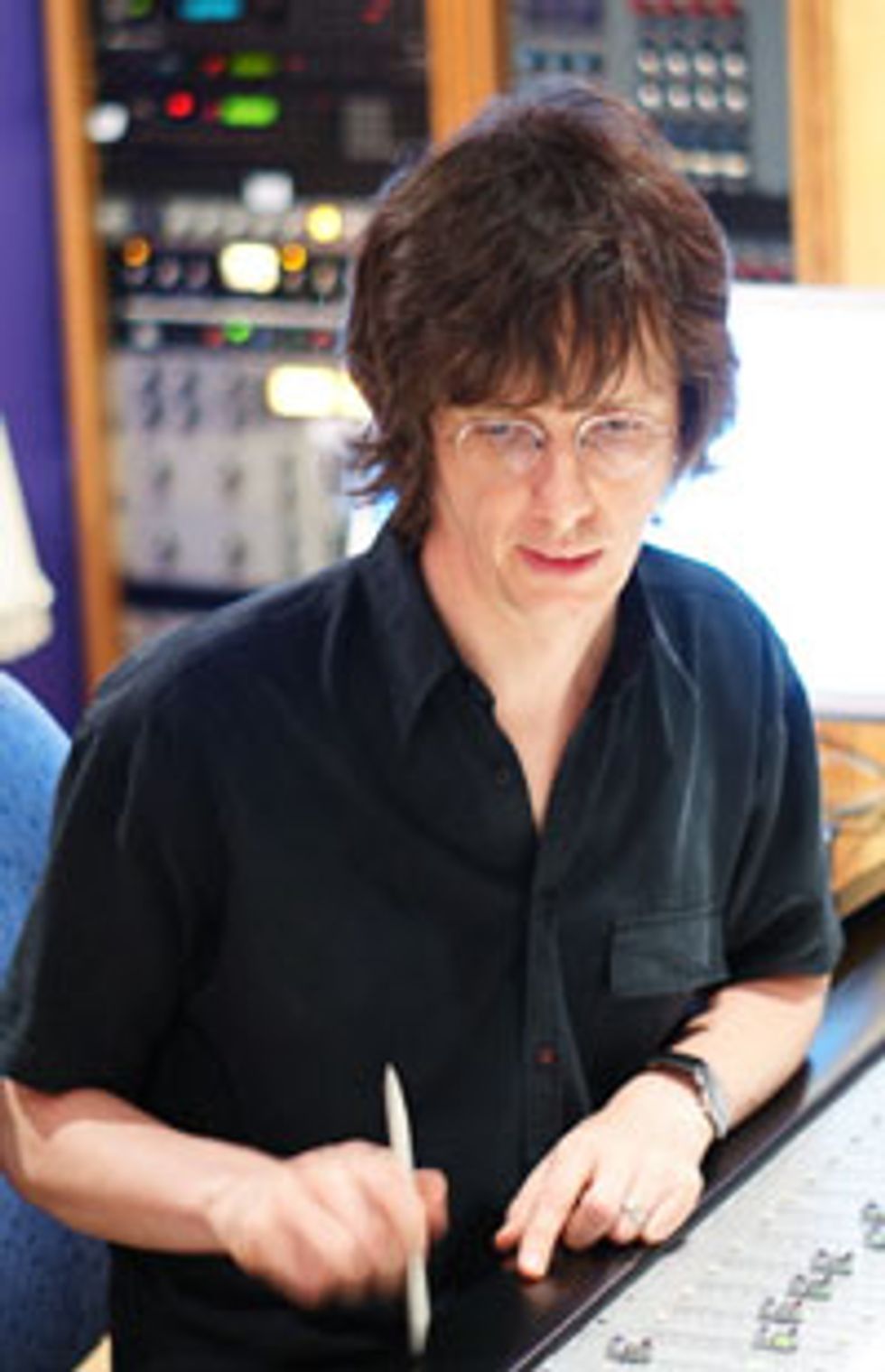
Engineer Chris Shaw on the Stars Sessions
Regarding the guitar-tracking portions of Nada Surf’s new The Stars Are Indifferent to Astronomy—which was recorded over the course of five days at Headgear in Brooklyn, New York—producer/engineer Chris Shaw says, “In general, it was easy because Matthew used THD Hot Plates to keep his volume at a reasonable level. And recording Doug was incredible, as he brought really well-thought-out parts to each song. The guy’s a monster.” To capture the remarkably textured and nuanced electric tones, Shaw used a Shure SM57 and an AKG 414. “I placed them around two-and-a-half to three inches from the cabinet, pointing straight ahead at the area halfway between the outside edge and the center of the speaker. To change things up when we were double tracking, I would move the mics closer or further back.” For the sparkling acoustic parts, including the Gibson J-200 doubled with a Nashville-tuned Guild jumbo on “When I Was Young,” Shaw employed an AKG 414 and a DPA/B&K 4011. “The 414 was pointed at the lower half of the bridge, at a 45-degree angle, while the 4011 was directed at the point where the neck joins the body and angled slightly toward the soundhole.” Both mics were six to nine inches away from the instrument. All mics were routed through a pair of Daking 52270 mic preamps/EQs and a pair of Empirical Labs Distressors for compression.
Is that usually the lyrical hook
or the melody—or both?
Both. It’s singing the hook and
thinking the chords. But even
if it’s just a little guitar hook
or a harmony—if I feel a little
haunted by it for a couple of
days, then I’m on to something.
Before a record gets done, I’ve
probably sung in my head or listened
to those little pieces a hundred
times each—because I just
do it and do it and do it until I
get sick of it, and then I throw
it away. But if I listen again and
again and again, and I don’t get
sick of it, then I think that might
be something that’s going to last.
Is the cringe-inducing stuff
usually the words you’ve
laid down, the whole thing
together, or either one of
those two?
Oh, it’s the words. A chord
progression will never make me
cringe, it’ll just make me yawn.
It can only be boring—it can’t
be, like … stupid. But it only
takes a couple of choice words
to make it stupid [laughs].
Has your process of writing
changed over the years?
It’s been pretty constant. But
when we did the release party
for [2010’s covers album] If I
Had a Hi-Fi, we prepared for
it by playing all of [2002’s]
Let Go in one club one night,
all of [2005’s] The Weight Is a
Gift another night, and all of
[2008’s] Lucky the next night in
another club. So, to brush up
on those songs, I had to listen to
those three records a lot, and it
really struck me that those versions
sounded so different from
how we ended up playing them
onstage—and also different from
the way I remembered writing
them and playing them in early
practices. I found that we’d sort
of grown into two bands—one
that’d kept the same energy
onstage over the years, and one
that had started to kind of slow
down in the studio.
At first I was really frustrated, thinking that we’d gone into some kind of groupthink. Like, “Okay, we’re older now, and this is our career, and we’re trying to make stuff that’s going to last. Slow down! Calm down now! Hold on a minute—don’t run away with it, you kids!” But then when we recorded Hi-Fi, it was so much fun and there was so much good energy coming from the drums, for example—Ira [Elliot] is an incredible live drummer— and I realized that it was actually all my fault. It was because I was finishing songs in the studio for years—not on purpose, but just because I’m an idiot and couldn’t finish them on time. I realized we play so differently when we really know the stuff and we’re not tracking while also thinking, “Hmm … should the chorus be two times or three times? Let’s try this one more time, but do the chorus twice.” That kind of thinking on the fly was keeping us from sounding like we do live—where we just kind of go for it. So I made a concerted effort this time to just write 10 songs, instead of working on 25 half-done ideas. I got a big kitchen table, spread out 10 pieces of paper, and just tried to finish.
Nada Surf frontman Matthew Caws rocks his Black Beauty in Mezzago, near Milan, Italy, last February.
Photo by Marina Ravizza
Well, it worked—the songs
are tight and they rock like
you guys have been playing
them for a while.
Exactly, and we haven’t had that
luxury in ages. We made our first
album [1996’s High/Low] twice.
We made it with a different
drummer with our pocket money
for a tiny label in Spain, and then
they ended up wanting to market
us to the rest of the world but we
were, like, “But you guys don’t
have anything going on outside
of Spain. We can’t give it to
you—sorry!” So when we made
it with Ric Ocasek, it was the
second time, so we knew those
songs cold. That was the only
other record we’ve made so fast.
This one we made in five days
of basic tracking. And, this time
we didn’t go out of town to get
away from home distractions, as
we’ve done for years. When we’ve
done that, you have that period
of closing up shop, packing up
your apartment, shipping some
gear, arriving in Seattle or San
Francisco, and then taking a day
off to recover from jet lag. When
you finally get back in the studio,
you’re, like, “Wait—how did that
[groove] feel again?” This time,
we finished the last practice on
a Sunday, rolled the gear three
blocks away to the nearest decent
studio, and the next day at noon
we were tracking. We didn’t have
to check a metronome, we didn’t
have to ask any questions—we
just did it. And it came out just
like it sounded in the practice
studio—which is exciting,
because now I don’t have to
listen to it through some filter,
like, “Yeah, well, y’know—it’s
an album. It’s a little different,
but that’s cool. How mature.”
This time, I hear it and I’m, like,
“Whoa—that’s us. Cool!”
The bass is locked in so tight
with the guitar on pretty
much all the songs. Do you
work extra hard with Daniel
to get a tight groove that really
maximizes that punchiness,
or is that lockstep power just
a result of how long you guys
have played together?
That’s just us playing together
for so long that, when we kind
of go into your basic, eighthnote
chugga-chugga thing, we’re
pretty locked—just because
that’s what we’ve been doing
for so long.
Did you track everything live
in the same room, with amps
in isolation rooms?
Yep, it was the three of us—me,
Daniel, and Ira. Doug [Gillard]
came in just for overdubs. My
guitar was going into two tweed
Deluxe replicas that my friend
J.J. built for me. He collects
new-old-stock parts [NOS], and
he made me a couple of tweed
Deluxe clones that have new
parts for everything that could
break down, and everything
that won’t break down is old.
Are those your go-to amps
now, or were those just what
you happened to use this time?
My go-to amp is a ’65 Fender
Deluxe Reverb reissue with a
Jensen Special Design speaker.
The Jensen speaker is important,
because the speaker the Deluxe
comes with is pretty brittle. I
usually use a THD Hot Plate,
too, to tame it down so I can
really listen to what it sounds like
without it hurting—because I
do like a pretty hyped-up Fender
sound. With an AC30 it’s impossible
to get the right tone without
blowing everybody off the
stage—you really have to crank
it. My go-to heavy sound is from
a Marshall JCM800 50-watt
head that I’ve had for years. Live,
I always run two Fender-type
amps—or Vox-type or Orange or
Silvertone—flanking a JCM800.
On this last tour in Europe, I
had an AC30 on one side and a
Deluxe Reverb on the other. The
two on the outside are always on,
and then the Marshall I turn on
and off the same way you would
a fuzz box. For years I tried channel
switching, but I got frustrated
with it, because in recording you
don’t do that—you get to the
chorus and you just add stuff
instead of taking it away. To
do that, I use a Morley George
Lynch Tripler pedal.
Do you have a go-to setup for
your jangly rhythm parts, and
if so, what are your preferred
pickup selections and amp
and effect settings?
The Deluxe Reverbs and tweed
clones are my go-to amps for
jangly parts. And I really only
have two main guitars in the
studio: One is a ’68 Les Paul
Custom Black Beauty, and then
I have a ’69 Tele that’s really
light. I tend to always be on
the bridge pickup—I’d rather
have the guitar always sound
bright, and then just dial the
treble back on the amp. The
only other variables are how
much gain to use on the amp
or whether to turn off the Hot
Plate and turn the amp down
a bit to get some sparkle, or to
bring the Hot Plate into it to
get some muscle. Live, though,
the amps tend to be pretty
cranked. I really like AC30s,
but I think the Deluxe is really
my favorite, because it does its
own kind of gain thing: You can
find a sweet spot where, if you
play lightly it’s crystal clear, but
if you dig in it’s crunched up.
That’s the best, because then it’s
just a question of your hands
deciding what you want to hear.
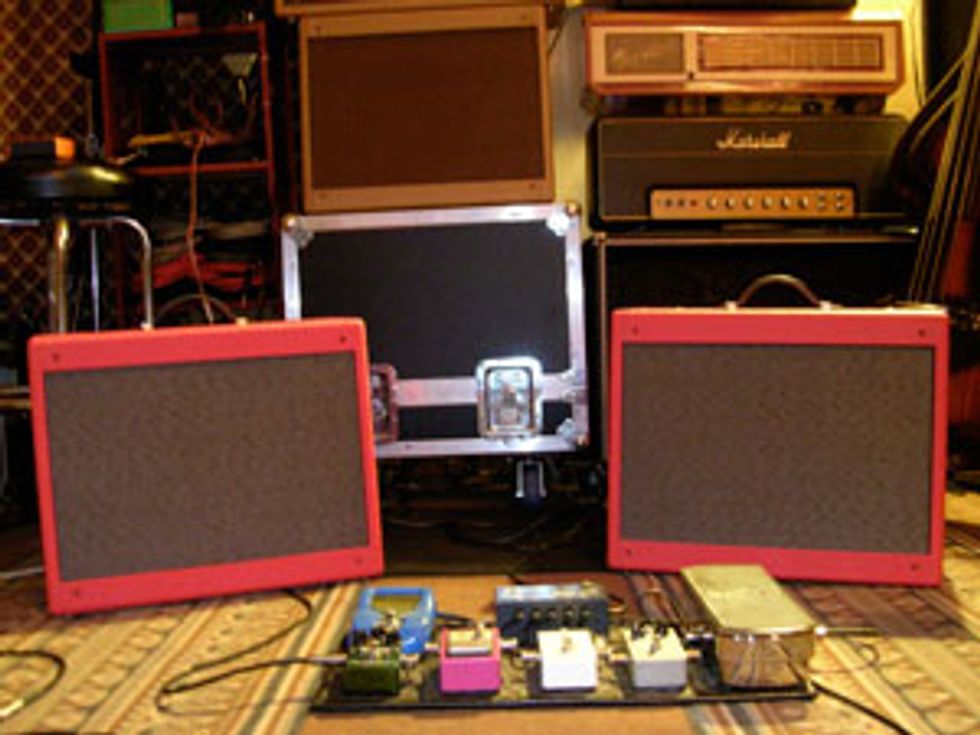
Caws’ Tweed Deluxe Clones
Nada Surf frontman Matthew Caws’ main amps for The Stars Are Indifferent to Astronomy were two tweed Fender Deluxe clones built by John “J.J.” Jenkins from TwangMaster Guitars (twangmasterguitars.com). “When I found Matthew was using THD Hot Plates to step down the wattage on his amplifiers, I asked him, ‘Why don’t you use amps that already have the wattage that you’re stepping your amps down to?’” Jenkins says. “Then I fired up the tweed Deluxe [clones] I built for myself, which run at about 15 watts or so, and I think he was an instant convert!”
To give Caws the tones he wanted in roadworthy amps, Jenkins says, “I wanted to build him a rig that preserves the vintage character of Leo Fender’s original 5E3 circuit, but that also enabled him to get parts and service anywhere his tours may take him. I started with a couple of fiberboard kits from Weber and a chassis from Mojotone. The transformers are Mercury Magnetics ToneClones—my go-to transformers. For the tone capacitors, I went with Jupiter paper-and-oils. They have a nice vintage sparkle and clarity, nicer than [Sprague] Orange Drops. The resistors are all carbon-comp, either Ohmite or NOS Allen-Bradleys. For tubes, I went with NOS RCA 5Y3 rectifiers, since there are plenty of them out there. The power tubes are new Tung-Sol 6V6s. They are the closest sounding to old RCA “black plates”—which are getting really hard to find at a good price. The 12AX7 preamp tube is also a Tung-Sol, and the 12AY7 is a gold-pin Electro-Harmonix. I used this tube compliment because they’re all still made or easily found in music or electronics stores worldwide. Another beauty of the 5E3 tweed Deluxe is that it doesn’t need tube biasing—you can just swap out the tubes and it will run fine. For speakers, I went with a 30-watt Weber 12A125A and a 25-watt Jensen P12R. The higher-wattage speakers give the amp a cleaner breakup, with more tube color and saturation than muddy speaker breakup, giving the amps a nice twang.”
Are the Les Paul and Tele
all-original?
Yep, I only changed the tuners
on the Les Paul—I put some
Waverlys on there. But of course
I kept the originals. I got both
of those at Main Drag Music in
Brooklyn about 15 years ago.
Are those the same guitars you
take on the road?
I only take Les Pauls on the
road. I have a 1960 Les Paul reissue
from 1996, and I also have
an Edwards, which is an incredible
Japanese knock-off made
by ESP. They can’t export them
here—they call them lawsuit
guitars because they’re so perfect.
They cost about a grand, they’re
light as a feather, and they sound
incredible. I actually may have
played that more than my Black
Beauty on this record.
Why do you only play Les
Pauls on the road?
For years, I was the only guitar
player, so I got completely
hooked on the thickness of the
sound. Even now, with Doug
playing with us on the road, I’m
still hooked—it’s what I know.
“Waiting for Something”
begins with a beautiful arpeggiated
part that’s doubled on
acoustic and an electric that’s
barely breaking up. When the
song kicks in, the driving, jangly
electrics lean a little to the
left side of the stereo field, and
you punctuate things occasionally
with drier, more straightahead
rock chords and riffs on
the right side—and then when
that muscular solo comes in
the middle of the stereo field, it
hits you right in the face. What
drives your decisions on stuff
like that—and do you make
panning decisions like that in
the studio during mixdown, or
do you actually envision parts
that way when you’re writing?
We do little mixdowns as we go.
I’m a big believer in really checking
out rough mixes and making
sure you don’t have to add too
much to it [at final mixdown]. I
do tend to want to double and
triple guitars all the time, and
Chris Shaw—Astronomy’s great,
great producer—did sort of hold
me back now and again.
“When I Was Young” has a
gorgeous acoustic 12-string
sound, with the bass strings
panned left and the trebles
panned right. What did you
play for that part, and how did
you capture such lush tones?
Oh, thanks! That’s actually a
6-string doubled with a guitar
playing Nashville tuning [a
6-string with the E, A, D, and
G strings tuned an octave higher
than normal]. When we made
The Weight Is a Gift with [producer]
Chris Walla, we were listening
to a lot of [Traveling Wilburys
and Beatles and Roy Orbison
producer] Jeff Lynne productions
and noticing how he puts
Nashville tuning on everything.
Which guitars did you use
for that, and why did you use
two guitars instead of a single
12-string to get that sound?
Because fingerpicking on a
12-string is a sloppier affair, and
I’m really not much of a fingerpicker.
I used a 1991 Gibson
J-200, and the Nashville tuning
was on a big, blonde Guild
F-50 jumbo.
One of the big lessons demonstrated
by these tracks is how
the different layers need to contrast—
rhythmically, texturally,
or tonally—and yet still lock in
and complement each other. For
instance, the middle section of
“When I Was Young” has these
anthemic, ringing chords on
electric guitar that give you an
image of a rock god in power
stance on a huge arena stage,
and it stands in such bold, stark
contrast to the lilting acoustic
beginning. How much time do
you spend thinking about and
working on contrasts like that?
I hope we’re not guilty of doing
the same thing over and over
again, but I always gravitate
toward certain things. I mean,
if a part is slow and big, I tend
to want to think in a Crazy
Horse way. Neil Young’s “Cortez
the Killer” [from 1975’s Zuma]
period—with those booming
chords—was a huge influence.
When I’m thinking that way,
I’ll go for this really saturated
sound and I won’t play much so
that the chords can really ring
out and bloom. It’s like when
you set a compressor the right
way on a crash cymbal. A lot of
people hit cymbals too hard so
they choke. That was a big thing
about [Led Zeppelin drummer
John] Bonham—he hit the
drums hard, but he didn’t hit the
cymbals hard. If you hit a crash
cymbal lightly, it’ll go whoooosh,
and I think guitars can be the
same way: If your amp’s really
singing, you can play less and let
the harmonics really do stuff.
Matthew Caws’ Gear
Guitars
1968 Gibson Les Paul Custom Black Beauty, 2011 Edwards LP-130, 1975 Gibson
Les Paul Standard, 1960 Les Paul Standard reissue, 1969 Telecaster, Fender Baritone
Jaguar, 1991 Gibson J-200, 1980 Guild F-50 (strung for Nashville tuning), 1971
Yamaha FG-180 (red-label Nippon Gakki version)
Amps
Two tweed 5E3-circuit Fender Deluxe clones made by John “J.J.” Jenkins of
TwangMaster Guitars, Fender 1965 Deluxe Reverb reissue with Jensen Special
Design speaker, early-’80s Marshall JCM800 50-watt head driving a 2x12 cabinet with
Celestions, early-’60s Silvertone Twin Twelve, THD 8 Ω (purple) Hot Plates on all amps
Effects
Fulltone OCD, Hughes & Kettner Rotosphere, Electro-Harmonix POG, MXR Dyna Comp
Strings, Picks, and Accessories
John Pearse .013 sets (acoustic), D’Addario .012 sets (electric), Jim Dunlop nylon .60 mm
Do you ever struggle with
having too many cool guitar
parts for a single song? How
do you know when to say,
“enough is enough”?
I don’t usually have too many
parts, but I can definitely have
too many tracks. At some point,
you have to go, “Okay, it’s getting
smaller.” The problem is that I’m
so addicted to doubling. But if
you’re, like, “Oh, let’s try this guitar
and this amp. And how about
these …,” before you know it,
you’ve got four tracks of rhythm
guitar—which can be okay if you
can control it in the mix. But
when you have too much, it starts
to get smaller [sounding]. The
transients are all getting squished,
because there are so many of
them—they’re blurring together.
So sometimes it does take a bit of
an effort to dial it back.
Your doubled guitar parts are
incredibly tight. Do you work
extra hard to track them that
way from the beginning, or do
you nudge them in Pro Tools
after the fact?
I’m not so into using Pro Tools
to move stuff around. I got my
big lesson on doubling with
Ric Ocasek on our first record:
Whenever we’d have a song with
a typical, here-comes-the-chorus,
kaboom-type of thing, we would
triple-track it with a Les Paul
and a Marshall. I’d do the first
track, and it was usually cool,
but for the second and third layers,
he’d make me do it, like, 15
times—until that first fraction
of a second hit like a wall. I’d hit
the chord on the second or third
track, and Ric would be, like,
“Yeah, that’s good. Do it again …
Good. Do it again … Good …
Do it again ….” And then I’d hit
one where it was just completely
invisible—and I’m a believer now.
When the stuff is really tight, it
just does something really special
to the impact of the song.

